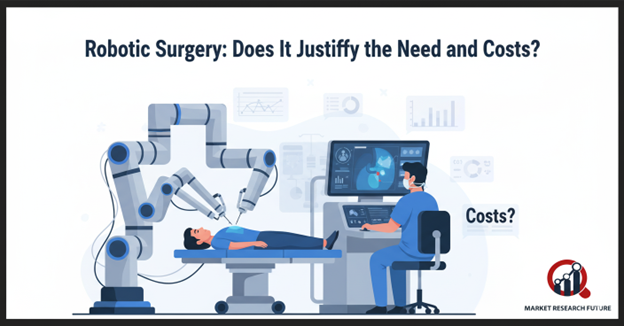
Surgical Robots Market Overview
The global surgical robots market is witnessing rapid evolution as advanced robotic systems redefine modern surgical practices. Robotic surgery is gaining momentum due to its potential advantages—minimized post-operative pain, reduced blood loss, shorter hospital stays, and faster recovery. These systems offer enhanced precision, dexterity, and control, particularly in microsurgeries and complex procedures.
However, alongside its benefits, cost concerns, training challenges, and technological barriers have sparked debate among healthcare experts. This article explores whether the adoption of surgical robotics truly justifies its financial and operational implications.
Key Market Drivers
1. Advancements in Minimally Invasive Surgery
Robotic-assisted surgeries are at the forefront of minimally invasive techniques, which offer reduced trauma, smaller incisions, and faster healing. The Da Vinci Surgical System dominates the field, performing over 563,000 procedures in the U.S. (2016) across gynecology (44%), general surgery (33%), and urology (19%).
Growing demand for precision-based interventions in fields like neurosurgery, orthopedics, and oncology is further fuelling adoption.
2. Enhanced Precision and Ergonomics
Surgical robots provide improved hand-eye coordination, tremor filtration, and magnified 3D visualization, which aid surgeons in executing delicate procedures. While some critics question whether robotic mediation affects coordination, microsurgical applications have clearly benefited from robotic precision.
3. Integration with Real-Time Imaging
Modern systems integrate with imaging modalities such as CT, MRI, and PET scans, enabling surgeons to visualize anatomy in real-time and improve surgical outcomes. This integration enhances accuracy in tumour resections and complex anatomical navigation.
4. Rising Demand for Remote and Specialized Surgeries
Emerging interest in remote surgery—where surgeons operate from distant locations—presents new frontiers, especially for battlefield operations and rural healthcare. Although still experimental, advancements in AI, 5G connectivity, and robotic control systems are making this vision increasingly viable.
Market Restraints
1. High Capital and Operational Costs
A major barrier remains cost—a single surgical robot may cost up to 2 USD Million, with per-surgery expenses rising by 1,500–3,000 USD compared to traditional methods. Additional requirements for large operating spaces, disposable attachments, and maintenance further add to expenses.
2. Steep Learning Curve
Surgeons require extensive training and simulation to master robotic systems. Limited availability of robots and low procedure volumes restrict access to hands-on experience, particularly in developing regions.
3. Procedural and Equipment Limitations
Most robotic surgeries are currently concentrated in gynecology, urology, and general surgery, with limited expansion into cardiac or neuro applications. Lack of standardized instruments, software compatibility, and haptic feedback also constrains broader adoption.
4. Risk Factors and Technical Failures
While touted for precision, robotic systems may introduce new risks—such as nerve injuries, gas absorption complications, and system failures. Prolonged operation times and anaesthesia exposure are additional concerns.
Future Outlook
1. Miniaturization and Portability
The future of surgical robotics lies in miniaturized systems with compact footprints suitable for modern operating rooms. Smaller, agile robots will improve access, reduce friction, and optimize spatial efficiency.
2. Rise of AI and Self-Learning Systems
Integration of artificial intelligence, haptics, and machine learning will enable self-learning robots capable of assisting surgeons more intuitively—enhancing precision, adaptability, and safety.
3. Growth of Remote and Autonomous Surgery
With advancements in real-time imaging, robotic control, and connectivity, telerobotic surgery may soon become a reality, addressing shortages of skilled surgeons in remote locations.
4. Focus on Cost-Benefit Optimization
To justify high capital expenditure, hospitals will increasingly assess long-term ROI, considering factors like reduced recovery time, patient satisfaction, and procedural efficiency.
Market Outlook
The surgical robotics market is poised for robust growth as healthcare systems transition toward technology-driven, precision-based interventions. While cost and accessibility remain key challenges, the benefits in clinical outcomes and operational efficiency are driving adoption across developed economies and emerging healthcare hubs.
Investments in training infrastructure, miniaturization, and standardization will be crucial to accelerating mainstream acceptance.
Conclusion
Robotic surgery stands at the crossroads of innovation and practicality. While critics highlight high costs and training barriers, proponents emphasize its potential to transform surgical care with precision, safety, and efficiency.
As technology evolves—through AI integration, miniaturized designs, and cost optimization—robotic surgery is likely to transition from specialized novelty to standard clinical practice.
The next decade will determine whether surgical robots truly deliver on their promise: better outcomes, lower risks, and justified investment.
About Market Research Future (MRFR)
Market Research Future (MRFR) is a trusted global market intelligence firm offering accurate, actionable, and forward-looking insights across industries. With comprehensive forecasts, data-driven analysis, and client-focused solutions, MRFR empowers organizations to make informed strategic decisions with confidence.
As a reliable partner in navigating dynamic market environments, MRFR helps identify emerging opportunities, anticipate market shifts, and craft winning strategies across evolving global landscapes.